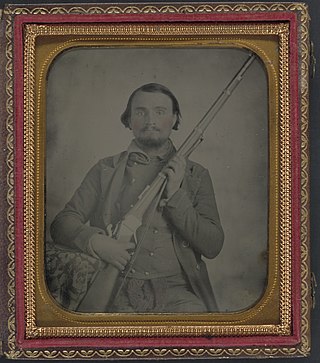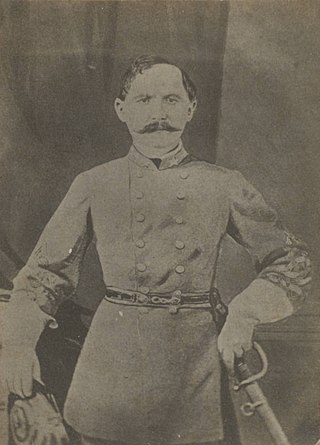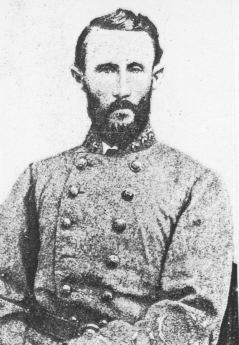
The Battle of Palmito Ranch, also known as the Battle of Palmito Hill, is considered by some criteria as the final battle of the American Civil War. It was fought May 12 and 13, 1865, on the banks of the Rio Grande east of Brownsville, Texas, and a few miles from the seaport of Los Brazos de Santiago, at the southern tip of Texas. The battle took place more than a month after the general surrender of Confederate forces to Union forces at Appomattox Court House, which had since been communicated to both commanders at Palmito, and in the intervening weeks the Confederacy had collapsed entirely, so it could also be classified as a postwar action.

Santos Benavides was a Confederate colonel during the American Civil War. Benavides was the highest-ranking Tejano soldier in the Confederate military.

The New Mexico campaign was a military operation of the trans-Mississippi theater of the American Civil War from February to April 1862 in which Confederate Brigadier General Henry Hopkins Sibley invaded the northern New Mexico Territory in an attempt to gain control of the Southwest, including the gold fields of Colorado and the ports of California. Historians regard this campaign as the most ambitious Confederate attempt to establish control of the American West and to open an additional theater in the war. It was an important campaign in the war's Trans-Mississippi Theater, and one of the major events in the history of the New Mexico Territory in the American Civil War.

The 32nd Texas Cavalry Regiment, sometimes incorrectly named Andrews's 15th Texas Cavalry Regiment, was a unit of volunteer cavalry mustered into the Confederate States Army in May 1862 and which fought during the American Civil War. The regiment was formed around companies from Richard Phillip Crump's 1st Texas Cavalry Battalion which fought in Indian Territory and at Pea Ridge. Many of the soldiers died of disease in the unhealthy camps near Corinth, Mississippi. The cavalrymen were dismounted in July 1862 and served as infantry for the rest of the war. The regiment fought at Richmond, Ky., Stones River, and Chickamauga in 1862–1863, in the Meridian and Atlanta campaigns and at Nashville in 1864, and at Spanish Fort and Fort Blakeley in 1865. The regiment's 58 surviving members surrendered to Federal forces on 9 May 1865.

The 12th Texas Cavalry Regiment was a unit of mounted volunteers recruited in Texas that fought in the Confederate States Army during the American Civil War. The regiment was enrolled in state service in September 1861 and in Confederate service the following month. The regiment fought at Whitney's Lane, Cotton Plant, and L'Anguille Ferry in 1862, Goodrich's Landing in 1863, and Blair's Landing and Yellow Bayou in 1864. The unit also participated in numerous skirmishes and scouts. It disbanded in May 1865.

The 14th Texas Cavalry Regiment was a unit of mounted volunteers in the Confederate States Army that fought during the American Civil War. The regiment mustered as cavalry in the fall of 1861 but the soldiers were dismounted in March 1862 and served as infantry for the rest of the war. The regiment fought at the Siege of Corinth, and at Richmond, Ky., Stones River, and Chickamauga in 1862–1863. The unit fought in the Meridian and Atlanta campaigns and at Nashville in 1864, and at Spanish Fort and Fort Blakeley in 1865. The remaining 100 members of the regiment were paroled by Federal forces on 9 May 1865.
The 13th Missouri Cavalry Regiment was a cavalry unit that served in the Confederate States Army during the American Civil War. In early April 1863, Captain Robert C. Wood, aide-de-camp to Confederate Major General Sterling Price, was detached to form an artillery unit from some of the men of Price's escort. Wood continued recruiting for the unit, which was armed with four Williams guns, and grew to 275 men by the end of September. The next month, the unit fought in the Battle of Pine Bluff, driving back Union Army troops into a barricaded defensive position, from which the Union soldiers could not be dislodged. By November, the unit, which was known as Wood's Missouri Cavalry Battalion, had grown to 400 men but no longer had the Williams guns. In April 1864, Wood's battalion, which was also known as the 14th Missouri Cavalry Battalion, played a minor role in the defeat of a Union foraging party in the Battle of Poison Spring, before spending the summer of 1864 at Princeton, Arkansas. In September, the unit joined Price's Raid into the state of Missouri, but their assault during the Battle of Pilot Knob failed to capture Fort Davidson.

The 2nd Louisiana Cavalry Regiment was a unit of mounted volunteers recruited in Louisiana that fought in the Confederate States Army during the American Civil War. Breazeale's Cavalry Battalion was formed in July 1862 and was augmented by five additional companies in September 1862 to form a regiment. It served for the entire war west of the Mississippi River in the Trans-Mississippi Department. The regiment fought at Georgia Landing, Fort Bisland, Irish Bend, and Brashear City in 1863 and Henderson's Hill and Mansfield in 1864. Afterward, the regiment fought in minor skirmishes before the Trans-Mississippi's final surrender on 26 May 1865.

The 26th Texas Cavalry Regiment was a unit of mounted volunteers from Texas that fought in the Confederate States Army during the American Civil War. The unit first organized in August 1861 as the 7th Texas Cavalry Battalion with seven companies for the purpose of patrolling the Texas Gulf Coast. In January 1862, three companies were added, and the unit was renamed the 26th Texas Cavalry Regiment. The original colonel resigned and was replaced by Xavier Debray, a Frenchman educated at Saint-Cyr military academy. Constant drilling gave the unit its reputation as one of the best disciplined in Texas. Until 1864, the regiment only fought minor skirmishes with Union landing parties. That year it fought at Mansfield and Pleasant Hill in the Red River Campaign. Instead of disbanding in May 1865, the regiment stayed intact and briefly guarded the city of Houston against marauders.

The 1st Texas Cavalry Regiment was a unit of mounted volunteers from Texas that fought in the Confederate States Army during the American Civil War. It was first organized as a 10-company regiment by Colonel Henry Eustace McCulloch in April 1861 and named the 1st Texas Mounted Rifles. In early May 1861, the regiment secured the surrender of the small Federal garrison of San Antonio. Except from a skirmish with Native Americans in November 1861, the regiment took part in no more actions. In April 1862, the unit was reduced to five companies and renamed the 8th Texas Cavalry Battalion. On 2 May 1862, William Overall Yager's 3rd Texas Cavalry Battalion was consolidated with the 8th Cavalry Battalion to form a new 1st Texas Cavalry Regiment under Colonel Augustus Buchel, a German soldier of fortune who emigrated to Texas in 1845. The regiment served on the Texas Gulf Coast in 1863 but later transferred to Louisiana. In 1864, it fought at Mansfield, Pleasant Hill, and Yellow Bayou in the Red River Campaign. After Buchel was killed at Pleasant Hill, Yager led the regiment for the rest of the war. The unit was included in the 2 June 1865 surrender.

The 29th Texas Cavalry Regiment was a unit of mounted volunteers from Texas that fought in the Confederate States Army during the American Civil War. Newspaper publisher Charles DeMorse formed the regiment at Clarksville, Texas, in July 1862 and became its colonel. The unit defended north Texas against Native American raids until March 1863, when it was ordered to march to Indian Territory. In July 1863, the regiment fought at Honey Springs. In October 1863, Richard Montgomery Gano assumed command of the brigade, which was troubled by poor morale and desertions. Gano's brigade moved to Arkansas where it fought at Poison Spring in April 1864. The regiment participated in a successful raid at Cabin Creek later that year. In early 1865, the unit was dismounted and added to an infantry division known as Walker's Greyhounds. The division was ordered to march to Hempstead, Texas, where it arrived in April 1865 and disbanded soon afterward.

The 30th Texas Cavalry Regiment was a unit of mounted volunteers from Texas that fought in the Confederate States Army during the American Civil War. Attorney Edward J. Gurley organized the regiment at Waco, Texas, in August 1862 and elected its colonel. Most of the recruits came from Waco and environs. Many men enlisted to escape the shame of being swept up by the Confederate Conscription Act, while others preferred to join the cavalry rather than serve in the infantry. For a year, the regiment remained within the state, defending the Texas Gulf Coast. In August 1863, the unit was reassigned to Smith P. Bankhead's cavalry brigade and ordered to march to Indian Territory. Since the brigade suffered from bad morale and desertions, in October 1863 Richard Montgomery Gano was appointed the new brigade commander. In March 1864, the bulk of the regiment raided Roseville, Arkansas, where Federal supplies were destroyed. After returning to Indian Territory, the regiment helped destroy a Union wagon train at Cabin Creek. In March 1865, the unit successfully resisted an order to dismount and serve as infantry. In May 1865, the regiment disbanded at Wallace Prairie near Austin, Texas.
The 35th (Brown's) Texas Cavalry Regiment was a unit of mounted volunteers from Texas that fought in the Confederate States Army during the American Civil War. The regiment was created by merging the 12th Texas Cavalry Battalion and Rountree's Texas Cavalry Battalion in October 1863. The new unit's commander was Reuben R. Brown. Its first assignment was to threaten Fort Esperanza, which Federal troops had recently captured. An attack on the fort failed at the end of December 1863. From February 1864 until the end of the war, the regiment patrolled the Texas Gulf Coast. The unit officially surrendered on 2 June 1865.
The 35th (Likens') Texas Cavalry Regiment was a unit of mounted volunteers from Texas that fought in the Confederate States Army during the American Civil War. The regiment was formed by consolidating Likens' Texas Cavalry Battalion and Burns' Texas Cavalry Battalion in October 1863. James B. Likens was appointed to lead the new unit, which was in a brigade first led by Hamilton P. Bee and later by Arthur P. Bagby Jr.. It fought at Mansfield and Pleasant Hill in 1864. The regiment moved to Beaumont, Texas, in early 1865, and surrendered there in June 1865.
The 36th Texas Cavalry Regiment was a unit of mounted volunteers from Texas that fought in the Confederate States Army during the American Civil War. The regiment was organized in March 1862 at Belton, Texas and surgeon Peter C. Woods was appointed to command it. The unit patrolled the Texas Gulf Coast and then spent the winter of 1862–1863 at Port Lavaca, Texas. It marched to Brownsville, Texas, in spring 1863 and later joined Hamilton P. Bee's brigade. This brigade transferred to Louisiana where it fought at Mansfield, Pleasant Hill, Blair's Landing, and Yellow Bayou during the Red River campaign in 1864. Afterward, the regiment traveled to Crockett, Texas, and then Galveston, where it was present when the men were paroled in June 1865.
The 13th Texas Infantry Regiment was a unit of volunteers recruited in Texas that fought in the Confederate States Army during the American Civil War. The regiment organized between September 1861 and January 1862, and was originally called the 4th Texas Volunteer Regiment. It spent its entire existence patrolling the Texas Gulf Coast between Matagorda and Galveston. The unit was actually made up of infantry, cavalry, and artillery units, but was not designated a legion. In April 1862, four infantry companies transferred to the 15th Texas Infantry Regiment, while three cavalry and one artillery company transferred to Reuben R. Brown's 12th Texas Cavalry Battalion. In fall 1863, three additional infantry companies of the 13th Texas Infantry were added when the 12th Cavalry Battalion consolidated with Lee C. Rountree's Cavalry Battalion to form the 35th (Brown's) Texas Cavalry Regiment. The regiment's soldiers suffered from poor morale due to the lack of military action, disease, monotony, and lack of food. The troops were only involved in a few skirmishes with the United States Navy. The formal surrender date was in June 1865, but by that time most of the soldiers had returned home.

The 8th Texas Infantry Regiment was a unit of volunteers recruited in Texas that fought in the Confederate States Army during the American Civil War. In May 1862, the 8th Texas Infantry Battalion mustered into Confederate service in Refugio County, Texas, with three companies. A fourth company joined in June 1862 and a fifth company soon afterward. After training at Banquete, Texas, until July 1862, the battalion fought in the Battle of Corpus Christi where it defended that city. The full regiment was created when the 8th Infantry Battalion was joined by Shea's Artillery battalion, making 1 cavalry, 5 infantry, and 4 artillery companies. The regiment fought at Fort Esperanza in November 1863 and was transferred to east Texas soon afterward. At this time, many soldiers from the 8th Infantry transferred to Waul's Legion and fought in the Red River campaign. The regiment mustered out of service on 22 May 1865.
The 21st Texas Infantry Regiment was a unit of volunteers recruited in Texas that fought in the Confederate States Army during the American Civil War. The regiment was formed in spring 1864 by consolidating William Henry Griffin's 21st Texas Infantry Battalion and Ashley W. Spaight's 11th Texas Cavalry Battalion. Spaight became colonel and Griffin became lieutenant colonel. Spaight's 11th Battalion existed as early as September 1862 with a strength of 400 men. In the 21st Regiment's only notable action, it ambushed and captured two Union gunboats in the Battle of Calcasieu Pass on 24 April 1864. The unit's duties were mainly guarding the Texas Gulf Coast. It moved to Marshall, Texas, in the winter of 1864–1865, then marched to Shreveport, Louisiana. In April 1865, the regiment returned to Texas before disbanding in May.

The 1st Texas Cavalry Regiment (Arizona Brigade) was a unit of mounted volunteers from Texas that fought in the Confederate States Army during the American Civil War. In fall 1861, John R. Baylor first conceived the idea to form a brigade of cavalry to conquer the southwestern territories for the Confederacy. Baylor recruited a four-company battalion of cavalry which was placed under the command of Philemon T. Herbert. In May 1862, the Confederate States Army empowered Baylor to organize five battalions of Partisan Rangers of six companies each. Since its aim was to recapture the territories lost during the New Mexico campaign, it was called the name Arizona Brigade. Henry Hopkins Sibley dismissed Baylor and appointed Peter Hardeman as the battalion's commander. It camped at Victoria, Texas, from summer 1862 to April 1863, part of the time under the temporary leadership of William Polk Hardeman. The unit, now a full regiment, joined Richard Montgomery Gano's cavalry brigade in the Indian Territory. In 1864, it fought at Poison Spring and Cabin Creek. Subsequently, the regiment was ordered to march to Hempstead, Texas, where it was dismounted. Later its numbers dwindled to 175 men. On May 15, 1865, the unit disbanded while camped near Richmond, Texas.












